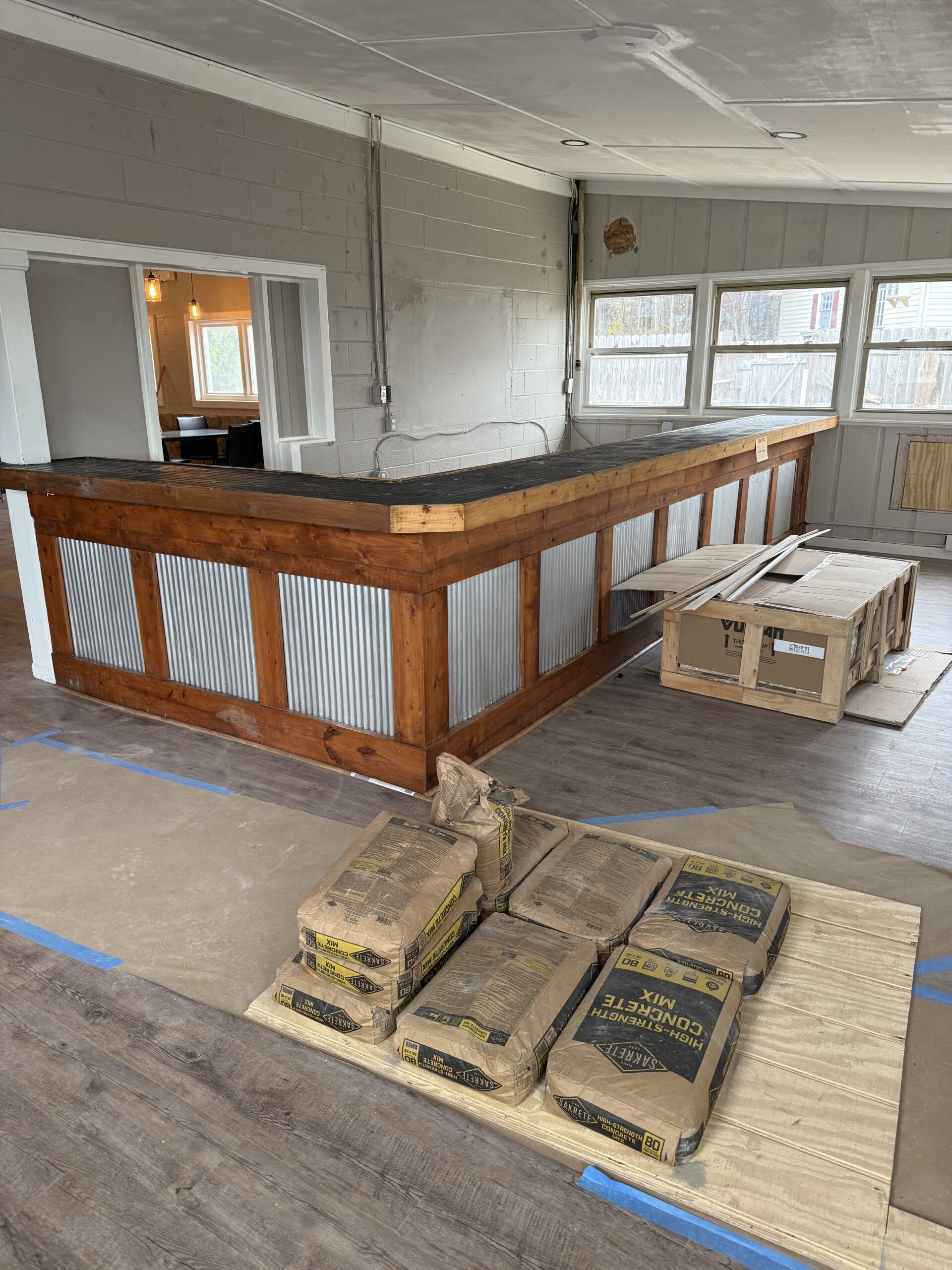
Photo courtesy of Aaron Burden.
The big story for the year was the drought that developed late spring and worsened over the latter half of the summer into the fall. We are still on the edge of slight drought conditions, but that should disappear by mid-January. We had spurts of big rainfall amounts to dampen the drought in early summer. From mid-July through mid-November, rainfall was almost non-existent. Tropical Storm Ophelia brought 3-5” of rainfall to the region in late September, which put a significant dent into the drought and saved us from much worse drought conditions.
The drought lowered the lake by about 14” below full pool by late November, and then 3 big rain events from late November into December filled the lake back up. Since the rains began on November 22, 2023, much of the Lake Anna area has received around 10” of rain.
Severe weather (winds, hail & tornadoes) occurrences were quite low. From my 31 years in Virginia, I thought the number of thunderstorm days was well below normal. One event was in April when several hail storms moved through the region. In June a thunderstorm produced a funnel cloud that moved over mid-lake.
I personally measured 40.49” of rain/melted snow for the year, which is just a bit below the normal of around 45”.
Snow was almost non-existent, but we saw a coating on the back edge of the December 11th storm.
Here are the biggest rainfall days of the year, measured at LKA HQ:
- 2/13/23 – 1.57”
- 4/7/23 – 1.09”
- 4/28-29/23 – 3.32
- 6.22/23 – 1.22”
- 6/25/23 – 1.02”
- 7/10/23 – 1.03
- 7/16/23 – 1.48
- 9/23-23/23 – 3.05
- 11/22/23 – 2.61”
- 12/11/23 – 2.32”
- 12/18/23 – 1.71”

I grew up an Air Force Brat. Traveled the country and lived in Georgia, Maine, New York, Hawaii and Oklahoma.
I fell in love with the weather in Oklahoma. My father was transferred to Tinker AFB in 1973. While in Temporary housing (a mobile home, which is the standard in Oklahoma) I experienced my first severe thunderstorm with strong winds and hail the size of baseballs. The next day I was in the base library looking up books on weather. The rest is history.
I graduated from the University of Oklahoma in 1983 with a Bachelor’s Degree in Meteorology. The first two years we took Calculus, Differential equations, Physics, Chemistry and Computer science classes with the Engineering Students. It was a grind. My degree is actually from the College of Engineering. The last 2-3 year’s focus was on Meteorology including Observational networks (Satellite, Radar, Surface), Physics, Thermodynamics, Dynamics, Synoptic, Winter Weather, Severe Weather and Climatology.
My first job out of college was with a small forecasting company in Oklahoma City. I was immediately put on TV (OETA) and Radio (WKY) as their broadcast Meteorologist. After two years in broadcasting, I decided to pursue the National Weather Service route and got a position in Toledo, OH as an intern. After a couple of years, I was promoted to a forecaster position at the Cleveland Forecast office. I quickly moved into the Weather Preparedness position and was responsible for all the preparedness activities in the state of Ohio.
In 1992 I decided to pursue other forecast opportunities and moved to the Meteorological Operations Division of the National Meteorological Center in Washington, DC. This group is now called WPC (Weather Prediction Center). There I fine-tuned my forecasting of Synoptic Weather with my focus on Heavy Convective Rainfall and Winter Storms, under the supervision of Dr. Louis Uccellini. He has written several books on East Coast Winter storms. I was promoted to a Senior Branch Forecast position during my tenure at MOD. Part of my job was to teach weather classes at COMET (Cooperative Program for Operational Meteorology, Education, and Training).
In 2012 I was given the opportunity to start up a new weather support group with the FAA (Federal Aviation Administration) in Warrenton, VA at the ATCSSC (Air Traffic Control System Command Center). The ATCSCC is where the FAA identifies solutions to air traffic inefficiencies in the NAS (National Air Space) for the CONUS (Continental United State). Weather impacts are the biggest impact on Aviation with yearly losses over 20 billion dollars. My job was to help lower these inefficiencies/costs by providing weather impact briefings and forecasts in order to keep the air planes moving as safely and efficiently as possible.
I retired in 2022 and now am running Lake Anna Weather, LLC.
Subscribe for Updates
Sponsors
latest articles
New Hometown Hearing Aid Center Advocates for Cognitive Health and Dementia Prevention [Sponsored]
![Featured image for “New Hometown Hearing Aid Center Advocates for Cognitive Health and Dementia Prevention [Sponsored]”](https://lakeanna.online/wp-content/uploads/2025/11/About_Us_Intro_Photo-1.png)
The Rustic Tavern’s Opening Delayed Amid Continuous Health Department Reviews

1st Annual Karaoke Contest at The Lounge on Lake Anna

10 Years of Entertainment at the Louisa Arts Center Gala

Louisa Leads in Hometown Spirit

Letter from the Editor: Mistletoe & Gratitude

Photo courtesy of Aaron Burden.
The big story for the year was the drought that developed late spring and worsened over the latter half of the summer into the fall. We are still on the edge of slight drought conditions, but that should disappear by mid-January. We had spurts of big rainfall amounts to dampen the drought in early summer. From mid-July through mid-November, rainfall was almost non-existent. Tropical Storm Ophelia brought 3-5” of rainfall to the region in late September, which put a significant dent into the drought and saved us from much worse drought conditions.
The drought lowered the lake by about 14” below full pool by late November, and then 3 big rain events from late November into December filled the lake back up. Since the rains began on November 22, 2023, much of the Lake Anna area has received around 10” of rain.
Severe weather (winds, hail & tornadoes) occurrences were quite low. From my 31 years in Virginia, I thought the number of thunderstorm days was well below normal. One event was in April when several hail storms moved through the region. In June a thunderstorm produced a funnel cloud that moved over mid-lake.
I personally measured 40.49” of rain/melted snow for the year, which is just a bit below the normal of around 45”.
Snow was almost non-existent, but we saw a coating on the back edge of the December 11th storm.
Here are the biggest rainfall days of the year, measured at LKA HQ:
- 2/13/23 – 1.57”
- 4/7/23 – 1.09”
- 4/28-29/23 – 3.32
- 6.22/23 – 1.22”
- 6/25/23 – 1.02”
- 7/10/23 – 1.03
- 7/16/23 – 1.48
- 9/23-23/23 – 3.05
- 11/22/23 – 2.61”
- 12/11/23 – 2.32”
- 12/18/23 – 1.71”

I grew up an Air Force Brat. Traveled the country and lived in Georgia, Maine, New York, Hawaii and Oklahoma.
I fell in love with the weather in Oklahoma. My father was transferred to Tinker AFB in 1973. While in Temporary housing (a mobile home, which is the standard in Oklahoma) I experienced my first severe thunderstorm with strong winds and hail the size of baseballs. The next day I was in the base library looking up books on weather. The rest is history.
I graduated from the University of Oklahoma in 1983 with a Bachelor’s Degree in Meteorology. The first two years we took Calculus, Differential equations, Physics, Chemistry and Computer science classes with the Engineering Students. It was a grind. My degree is actually from the College of Engineering. The last 2-3 year’s focus was on Meteorology including Observational networks (Satellite, Radar, Surface), Physics, Thermodynamics, Dynamics, Synoptic, Winter Weather, Severe Weather and Climatology.
My first job out of college was with a small forecasting company in Oklahoma City. I was immediately put on TV (OETA) and Radio (WKY) as their broadcast Meteorologist. After two years in broadcasting, I decided to pursue the National Weather Service route and got a position in Toledo, OH as an intern. After a couple of years, I was promoted to a forecaster position at the Cleveland Forecast office. I quickly moved into the Weather Preparedness position and was responsible for all the preparedness activities in the state of Ohio.
In 1992 I decided to pursue other forecast opportunities and moved to the Meteorological Operations Division of the National Meteorological Center in Washington, DC. This group is now called WPC (Weather Prediction Center). There I fine-tuned my forecasting of Synoptic Weather with my focus on Heavy Convective Rainfall and Winter Storms, under the supervision of Dr. Louis Uccellini. He has written several books on East Coast Winter storms. I was promoted to a Senior Branch Forecast position during my tenure at MOD. Part of my job was to teach weather classes at COMET (Cooperative Program for Operational Meteorology, Education, and Training).
In 2012 I was given the opportunity to start up a new weather support group with the FAA (Federal Aviation Administration) in Warrenton, VA at the ATCSSC (Air Traffic Control System Command Center). The ATCSCC is where the FAA identifies solutions to air traffic inefficiencies in the NAS (National Air Space) for the CONUS (Continental United State). Weather impacts are the biggest impact on Aviation with yearly losses over 20 billion dollars. My job was to help lower these inefficiencies/costs by providing weather impact briefings and forecasts in order to keep the air planes moving as safely and efficiently as possible.
I retired in 2022 and now am running Lake Anna Weather, LLC.
Subscribe for Updates
Sponsors
latest articles
New Hometown Hearing Aid Center Advocates for Cognitive Health and Dementia Prevention [Sponsored]
![Featured image for “New Hometown Hearing Aid Center Advocates for Cognitive Health and Dementia Prevention [Sponsored]”](https://lakeanna.online/wp-content/uploads/2025/11/About_Us_Intro_Photo-1.png)
The Rustic Tavern’s Opening Delayed Amid Continuous Health Department Reviews

1st Annual Karaoke Contest at The Lounge on Lake Anna

10 Years of Entertainment at the Louisa Arts Center Gala

Louisa Leads in Hometown Spirit

Letter from the Editor: Mistletoe & Gratitude

Spotsylvania Tourism Growth Outpaces Statewide Averages with 35% Surge Since 2019
Article By Jen Bailey
![Featured image for “[Spotsylvania] New Speed Enforcement in School Zones”](https://lakeanna.online/wp-content/uploads/2025/09/Blog-pic-scaled.jpg)
[Spotsylvania] New Speed Enforcement in School Zones
Article By Jen Bailey








